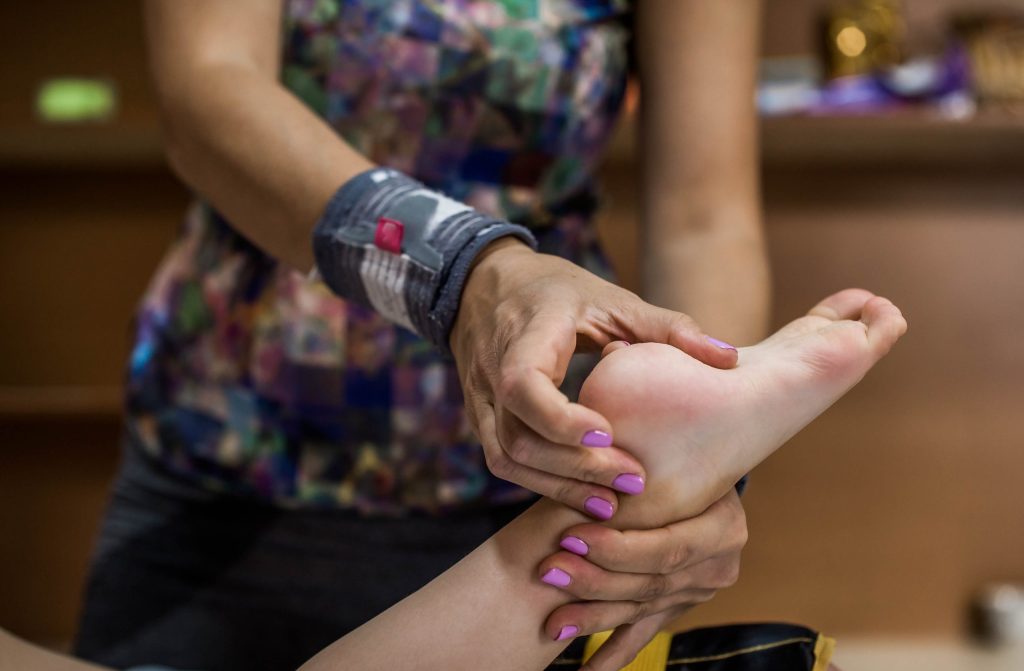We’ve all experienced that nagging sensation in the heel of your foot that can make every step feel like walking on a sharp, jagged surface reminiscent of broken glass. Heel pain is a common ordeal many people face, and it can significantly impact your daily life, preventing you from enjoying simple activities or even just walking comfortably.
According to a study published in the Journal of Foot and Ankle Research, heel pain affects approximately 1 in 10 adults, showing the widespread nature of this condition. The road to recovery requires dedication, compassion, and knowledge, which we hope to impart through this guide. So, let’s begin your journey to rediscovering the joy of walking without that feeling of broken glass underfoot.
 Understanding Heel Pain
Understanding Heel Pain
Heel pain is a common issue that affects individuals of all ages and fitness levels. Heel pain is a common foot condition often caused by inflammation of the soft tissue that connects the heel bone with the toes, known as plantar fasciitis. This inflammation may result from factors such as excessive weight, a new intense exercise routine, poor shoe support, arthritis, or underlying medical conditions.
Before effectively managing heel pain, you must first understand the causes and symptoms. Heel pain in the foot often results from common conditions like plantar fasciitis or Achilles tendinitis. Still, it can also be a symptom of more serious issues like fractures, nerve irritation, or arthritis. Signs of heel pain include sharp pain in your heel when you first get up in the morning, constant ache at the bottom of your foot, or a dull ache that intensifies when you stand or walk.
Common Causes Of Heel Pain
Several underlying causes for heel pain in the foot require different treatments.
1. Plantar Fasciitis
plantar fasciitis is a common cause of heel pain that occurs due to inflammation in the plantar fascia, a thick band of tissue running across the bottom of your foot. This tissue connects your heel bone to your toes and helps maintain the arch of your foot.
The condition is particularly prevalent among runners and those whose jobs require much walking or standing, especially on hard surfaces. Overweight individuals and those with flat feet or high arches are more likely to develop Plantar Fasciitis.
2. Heel Spurs
Heel spurs are typically caused by long-term strain on the muscles and ligaments of the foot. Factors contributing to heel spurs include abnormal walking gait, running or jogging, poorly fitted or worn-out footwear, obesity, and specific exercises, such as those that put excessive stress on the heel (like jumping activities).
The primary sign of a heel spur is intermittent or chronic pain when walking, running, or jogging. The pain is often described as a sharp stabbing or aching sensation that starts at the bottom of the foot and progresses up into the arch of the foot.
3. Achilles Tendonitis
Achilles Tendonitis is a common condition that causes pain along the back of the leg near the heel, specifically in the Achilles tendon, the largest tendon in the body. This tendon connects your calf muscles to your heel bone and is used when you walk, run, climb stairs, jump, and stand on your tiptoes.
The condition typically results from overuse, specifically repetitive or intense strain on the Achilles tendon. It’s prevalent among runners and athletes participating in running or jumping sports.
4. Bursitis
Bursitis commonly occurs near joints that perform frequent repetitive motions, such as elbows, shoulders, hips, and knees. In the context of foot pain, bursitis can affect the heel and cause localized pain and discomfort. The main cause of bursitis is repetitive stress or overuse of the joint, although it may also result from trauma, infection, or underlying conditions such as gout or arthritis.
Symptoms To Watch For
- Sharp, stabbing pain in the heel or bottom of the foot
- Pain that is worse in the morning or after periods of rest
- Swelling and redness in the heel area
- Difficulty walking or putting weight on the affected foot
 Diagnosis And Treatment Of Heel Pains
Diagnosis And Treatment Of Heel Pains
A comprehensive diagnosis is the first step towards understanding and healing your heel pain. Professionals outline the contours of plantar heel pain through a combination of your medical history, X-ray, foot mechanics, and state-of-the-art diagnostic imaging tests.
Each cause of heel pain comes with its unique treatment strategy. Our toolbox is filled with effective methods, ranging from the simple insertion of orthotic devices in supportive shoes to managing pain and inflammation with anti-inflammatory drugs or even, in some cases, injection therapies in the affected area. Early treatment is often the key to managing the condition effectively.
Physical therapy and exercise are among the real heroes in treating heel pain in the foot. Targeted strengthening of muscles and tendons, especially the calf muscles, can help you get back on your feet. An array of strategies, including specific exercises, arch pain relief, shoe inserts, and orthotics, can all work synergistically to counter the debilitating effects of conditions like chronic plantar fasciitis.
Regaining Your Stride: Treatment Options For Heel Pain
Treatments for heel pain in the foot often begin with less invasive approaches and progress to more intensive methods if the pain persists. These are the first steps to address heel pain in the foot:
- Rest And Ice: One of the first steps in managing heel pain is to rest and apply ice to the affected area. The rest helps reduce stress on the painful heel, while ice reduces inflammation. Avoid activities that can strain the foot, and use an ice pack for 15 to 20 minutes several times daily.
- Pain Relievers: Over-the-counter nonsteroidal anti-inflammatory drugs can help manage swelling and pain. Always follow the manufacturer’s instructions and consult your doctor if the pain persists.
- Exercise And Stretching: Regular stretching and strengthening activities for your foot and calf muscles can prevent and treat heel pain. Exercises such as calf, toe, towel, and stair stretches can be particularly helpful.
- Proper Footwear: Your choice of shoes can significantly affect your heel health. Opt for shoes with good arch support, a slightly elevated heel, and plenty of cushion. Avoid wearing high heels or flat shoes for long durations.
- Orthopedic Insoles: Orthotic devices or arch supports can help reduce pressure on the heel and provide extra comfort. Consult a podiatrist to get suitable insoles tailored to your foot’s shape.
- Physical Therapy: Exercises tailored to stretch and strengthen foot and lower leg muscles could assist with healing.
- Orthotics: Shoe inserts, either custom-fitted or store-bought, can correct structural issues and cushion your step.
- Steroid Injections: These can help to suppress inflammation in the affected area, leading to temporary relief.
- Shockwave Therapy: A therapy that uses sound waves to stimulate healing in injured tissue.
Surgical Options
Surgery may be considered when conservative treatments fail to resolve the heel pain and are dependent on the specific condition and cause of pain. Depending on the individual case, these treatment methods can be used alone or in combination. A healthcare provider will advise on the best treatment course for heel pain.
 Prevention Of Heel Pain
Prevention Of Heel Pain
Adopting a healthy lifestyle and caring for your feet is essential to prevent heel pain. Following these guidelines can help reduce the risk of developing heel pain:
- Stretch Regularly: Incorporate daily stretching routines focusing on calf muscles, Achilles tendon, and the plantar fascia. Make sure to stretch before and after exercising.
- Maintain Healthy Weight: Extra pounds can add stress to your feet, especially on your heels. Maintaining a healthy weight to relieve pressure and minimize heel pain is crucial.
- Wear Appropriate Footwear: Choose shoes with good arch support, cushioning, and a slightly raised heel. Avoid high heels or excessively flat shoes, and replace worn-out shoes with adequate support.
- Avoid Overexertion: Don’t overexert yourself and listen to your body’s signals. If pain develops, rest and avoid excessive strain on your feet. Gradually increase your activity levels instead of jumping into high-intensity workouts.
If conservative methods don’t provide adequate relief, your doctor may suggest surgical options. The procedure generally involves detaching the plantar fascia from the heel bone. This option is often the last resort and is advised only in persistent, severe cases.
Dealing with heel pain can indeed often feel like you’re constantly walking on broken glass. However, you can effectively manage this discomfort with the right interventions, strategies, and professional care.
Heel pain in the foot can drastically affect your daily life, but it doesn’t have to be a life sentence. You can regain your stride and walk without pain with proper care, treatment, and preventive strategies. If you are struggling with persistent heel pain, do not hesitate to contact a healthcare provider to start on the path to recovery.
COMMITTED
TO EXCELLENT SERVICE
Our philosophy has been that the patient always comes first.
EMERGENCY OPERATOR
24 HOURS
Get emergency care from a specialist right from the start. Don’t go to an urgent care, ER or general doctor. Come straight the specialist.




